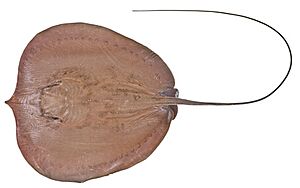Freshwater whipray facts for kids
Quick facts for kids Freshwater whipray |
|
|---|---|
 |
|
| Conservation status | |
| Scientific classification | |
| Genus: |
Urogymnus
|
| Species: |
dalyensis
|
| Synonyms | |
|
|
The freshwater whipray (Urogymnus dalyensis) is a type of stingray that lives in large rivers and estuaries in northern Australia. For a long time, people thought this ray was just a smaller version of the much bigger giant freshwater stingray found in Southeast Asia.
These rays usually grow to about 1 m (3.3 ft) wide. They have a round, flat body, a snout that sticks out, and a thin tail without any fins. Their top side is plain brown, and their underside is white with dark edges. Interestingly, they can sometimes move onto land and breathe out of water for up to 7 minutes! Freshwater whiprays are active hunters, eating small fish and shrimps. Luckily, they are not currently in serious danger.
Contents
Discovering the Freshwater Whipray
The first known freshwater whipray was found during a science trip in 1989. This happened in the Daly River, which is how the ray got its name. For a while, some scientists confused it with other stingrays, like the estuary stingray or the giant freshwater stingray.
However, later studies looked closely at their bodies and their DNA. These studies showed that the freshwater whipray is actually a unique species. It was officially named in 2008 by Peter Last and B. Mabel Manjaji-Matsumoto. The first young male ray used to describe the species was 62 cm (24 in) wide. It was found in the Pentecost River.
Where Freshwater Whiprays Live
The freshwater whipray is the only Australian stingray that lives only in fresh and brackish water (a mix of fresh and salt water). So far, it has been seen in many large, tropical rivers across northern Australia. These include the Daly, Fitzroy, Gilbert, Mitchell, Normanby, Ord, Pentecost, Roper, South Alligator, and Wenlock Rivers. It might even live in most big rivers in this part of Australia.
Scientists also think that stingrays found in the Fly River in Papua New Guinea might be this same species. These rays live on the river bottom, usually in water that is about 1–4 m (3.3–13.1 ft) deep. Most of them prefer water that isn't very salty. However, some have been found in water that is quite salty.
What Freshwater Whiprays Look Like
The freshwater whipray has a body shape like an apple. It is about as wide as it is long. The front edges of its body are almost straight. Its snout is fairly long and flat, with a pointy tip that sticks out. Its eyes are small, and right behind them are much larger openings called spiracles.
Inside its mouth, there are two large bumps called papillae in the middle. There are also 2 to 3 smaller bumps near the corners. This ray has many rows of tiny teeth, about 37 on the top and 45 on the bottom. Its small pelvic fins are less than a fifth of its body width. The tail is thin and whip-like, about twice as long as its body. It has one sharp, serrated (saw-like) stinging spine on top of its tail. Unlike some other rays, it does not have fins on its tail.
The entire top of the ray's body is covered in small, rough bumps called dermal denticles. These bumps are heart or oval-shaped near its "shoulders" and become tiny near the edges of its body. There are also about 5 larger bumps in the center of its back. The tail is also rough with bumps, especially a row of larger ones before the spine.
The top of the ray is light brown to gray-brown. The color gets darker, almost black, past the tail spine. The underside of its body and tail is white. It has dark brown bands around the edges of its fins. The inside edge of these bands is uneven, breaking into small spots that reach its belly. This species can grow up to 1.24 m (4.1 ft) wide, but most are about 1 m (3.3 ft) across. The freshwater whipray looks a lot like the much bigger giant freshwater stingray. However, it has a shorter, blunter snout and narrower dark bands on its underside.
Life and Habits
Scientists don't know a lot about the daily life of the freshwater whipray. We do know that it eats small fish and shrimps. People have seen them lunge up riverbanks to catch prey that gets caught in the water they push. One male ray was found to be a teenager when it was 88 cm (35 in) wide.
Conservation and Threats
The International Union for Conservation of Nature (IUCN) believes that freshwater whiprays in Australia are doing well. However, there is some worry about the rays living in the South Alligator River. This river is in Kakadu National Park. These rays might be harmed by pollution from old uranium mines upstream.


